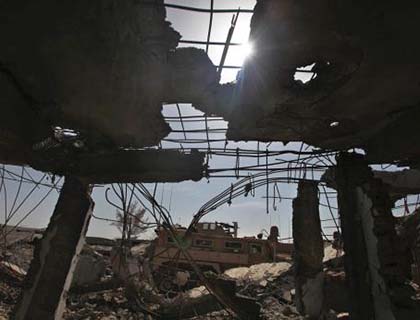The rise in civilian casualties has been attributed to a surge in battles between government forces and the armed opposition, mainly the Taliban. And while the war, for Afghans, is not over, it is clearly morphing. With international forces largely withdrawn from the provinces, insurgents have taken the fight back to the battlefield where indiscriminate weapons such as mortars and rockets prevail.
As a result, 2014 saw a 54% increase in civilian casualties from fighting, while the number of victims from improvised explosive devices, such as roadside bombs, remained almost the same.
The UN attributes 72% of the civilian casualties to insurgents and 14% to government forces. As the army and police have assumed responsibility for security, insurgents have moved the fight closer to district centers and residential areas, increasing the risk to civilians.
Insurgents have also targeted civilians directly, as with the killing of 34 mine clearers and the torching of houses belonging to government officials. Recently a female provincial council member died from wounds sustained in a bomb blast in Nangarhar province.
However, the consequences of the fighting go beyond just casualties. 2014 saw an 8% increase in people displaced by conflict, bringing Afghanistan’s overall number of internally displaced people over 800,000, said the UN.
Meanwhile, the number of Afghan refugees who returned home from Pakistan surged in the first half of the year, exceeding the number who crossed the border in the whole of 2014, said the UN refugee agency (UNHCR).
Reports say that more than 139,000 Afghans have returned from Pakistan since the start of the year, many saying they did so because of alleged harassment after the deadly Pakistani Taliban attack on a school in Peshawar last December. Many of the Afghan refugees said they had to return to their homeland because the situation in Pakistan had become too difficult, though some were unable to reach their homes in areas affected by fighting.
“In today’s situation where the fighting is spreading and increasing across the country, many returning refugees become displaced in Afghanistan,” UNHCR spokesperson Mans Nyberg is cited as saying. “They may not be able to go back their home village so they choose to go to a secure place, which is usually a city or a larger town somewhere. That happens in many cases.”
The escalated militancy on one hand and the flooding of Afghan refugees on the other hand compound the challenges. Those who return home in the hope of breathing a sigh of relief in their own homeland and dream to live in a society void of humiliation and harassment will encounter further problems – mainly violence and bloodshed. To their unmitigated chagrin, the burgeoning political turmoil will spoil their dreams for utopia and the nascent democracy will not be a panacea for their problem.
A number of returnees are believed to be the second and third generation born outside the border and Afghanistan seems to them completely a new country. Encountering an impromptu situation, they will have to deal with worse scenario. Nyberg has further said, “In today’s situation where the fighting is spreading and increasing across the country, many returning refugees become displaced in Afghanistan… Afghanistan is still the largest protracted refugee situation in the world.”
It is patently obvious that people are highly prone to political instability and take the brunt of militancy and terrorism. Currently, the public are wrestling with a number of difficulties such as unemployment, economic recession, etc. which stem from political upheaval. Moreover, the abduction of citizens including women – which is an unprecedented episode in the country – and the rise in death toll aggravate their hardships. In short, people suffer the burgeoning challenges in one way or another.
After all, fomenting racial tension is likely to be the militants’ new tactic used to harm the state. Recently, the armed militants’ abduct simple travelers, from a particular ethnic minority, to gain priority from the government. Their intents and purposes are to provoke the anger of an ethnicity against another and to fan the flame of animosity.
Seemingly, the world has forgotten Afghanistan and all the challenges going on across the country. The foreign forces left our bleeding nation in the lurch and the international community has decentralized its financial and military supports. “It’s a concern that the world is forgetting about Afghan refugees, and donors are turning their attention elsewhere,” Nyberg said. With the withdrawal of the US-led NATO troops, the war has been brought to battlefields once more and the self-styled Islamic State group has emerged in the country the same as in Iraq. Thus, it is feared that the scenario of Iraq will be repeated in Afghanistan.
One will conclude that Afghanistan is in the grip of political syndrome and dependent to foreign military and financial aids. Contrary to the public ambition, the security situation has been deteriorated with the establishment of National Unity Government (NUG) and the citizens’ ballots have been changed into bullet targeting them in some ways. The wall of mistrust between nation and state is growing higher with each passing day. To bridge the gap, the state has to put an end to the political chaos. Moreover, the world, particularly the international community, is supposed not to forget Afghanistan – yet it is the state to earn the trust of the international community through a sound administration.

